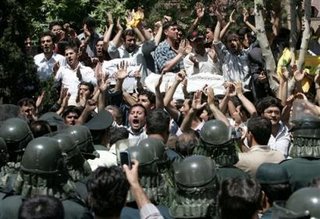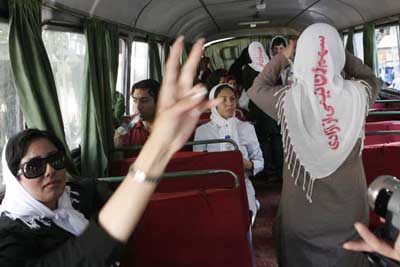In 1979 the Iranian revolution toppled the late Shah with the masses demanding their freedom and the right to shape their destiny through a republic that offers elections. But the revolution took an unexpected detour when its leader designated himself as an unelected deity that knew what is best for the people. The current government of Iran is in effect run by a “Supreme Leader” that is chosen amongst another unelected committee of clerics, named the “Evaluate Father”. This Supreme Leader has final say as to how the country is run. The elections that are held in the country can only take place with his approval. The effects of this dictatorship can be seen today throughout daily life in Iran. Laws passed by the Iranian Parliament to ban torture by the government, to grant women equal rights as well as curtailing the power of the ruling clerics were all rejected by the Supreme leader. The economy is in shambles with widespread corruption. Unemployment is rampant in a country where there is a 79.4% literacy level. Most of the Iranian college graduates flee and take jobs in outside countries. Civil Liberties infringement is an everyday occurrence with restrictions placed on citizens for who can be nominated to run for office, what material can be published in newspapers, who can form peaceful assembly as well as how one chooses to observe his or her religion. As long as the above activities are done in a fashion that would support the Supreme Leader’s dictatorship, it is given approval and can take place. Otherwise, the parties involved are subsequently jailed and tortured. For example, a journalist that published a poll stating 90% of the people it surveyed were in favor of relations with the U.S., was arrested and put in jail for about six years. Another example of civil liberty infringement is if a woman does not wear a veil, she will be sentenced to 60 lashes. The Islamic vigilante force would install fear in society by brutally suppressing any individual or group that dared to voice a contradiction. But the times are changing; the people are becoming active to bring about modifications with the internet, demonstrations of many groups as well as various celebrity activists.
New technology brings about change and the promise of improvement in people’s lives. The internet delivered these promises and so much more with its capability to disperse information, photos as well as video footage of events without the need to divulge one’s personal identity. The first publicized dissent against the Islamic Regime occurred in 1999, when a group of University students spontaneously coalesced in the University grounds and voiced complaints against the regime. Later that very night, the Islamic vigilante forces stormed into dormitories, beat the students, and in some cases threw them out of their second or third floor dormitory windows. The Islamic regime had assumed that this dissent would go unnoticed quietly just like all of the previous ones. But that story burst into the newspapers, as well as kicked off the creation of partnerships and websites promoting change. According to a June 16, 2006 article from BBC, currently there are more than 100,000 active blogs in Iran [1]. These blogs have various functions. Some simply observe and report occurrences in Iran, while others try to connect with fellow Iranians by writing about their experiences. Additionally many blogs utilize the internet to broadcast demonstrations and events that are taking place, form online petitions to rally signatures for freeing many wrongly jailed individuals in Iran, as well as publicize and list who amongst themselves has been jailed and give first hand accounts of the aftermath of specific demonstrations. An example of sharing experiences is the account of how a blogger legally exchanged her “Mehrieh”, money that a husband owes his wife in the event of a divorce, for her right for divorce should she want it, the right to joint custody of a child, as well as the right to study and travel. Examples of photography of events can be found at www.kossoof.com as well as www.nasiriphotos.com. When a group of women wanted to advertise their intent for a peaceful demonstration for gender equality, they had an online flier circling around the various blogs.

1: Iranian women's online flier advertising their demonstration
These online fliers tend to take a life of its own, and once the fliers are posted in a couple of blogs, it will find its way to multitudes of others without any effort of the event organizers. This is due to the fact that the average Iranian is unhappy with the current state of the country and wants to do his/her part in hopes of improving their bleak future. According to the observations of one Iranian: “The situation of the people of Tehran is akin to smooshing a population together like a can of sardines, and then beating on their heads with a hammer. There is no middle class; all are either poor or rich. Everyone wants to immigrate out of the country.”
Events that have been occurring and being reported online have been exciting and impressive. Diverse factions of the Iranian population have been active in the dissent arena. This past February, the bus drivers staged a strike asking for higher wages and better working benefits. They signaled their unity with bus drivers not showing up to work. Of course the regime’s response was heavy handed, bursting into the union member’s homes and arresting wives and infants from their homes if the union member was not present himself. On March 8th, 2006 women gathered together in honor of World Women’s day to demand equal rights, again meeting brutal Islamic police. The demonstrations are becoming more frequent, and its members becoming more creative in their method of dissent. Earlier in June, girls grouped together in front of the Azadi Stadium demanding their rights to enter and watch the soccer games. Since the Islamic vigilante forces normally grab the demonstrator’s signs and shred them to pieces on the spot, they had their slogans printed on their veils. The Islamic vigilante forces seethed with anger at the sight of the slogans they could not destroy.

2: Iranian women's veils with printed slogans demanding gender equality. Picture by Omid Salehi taken from www.parastood.com’s account of the rally.
On May Day (May 1st, 2006), the Islamic Republic staged a government forced/assisted demonstration, only to have it overtaken by average workers, demanding better working conditions and voicing with their economically hard conditions under the regime. They demanded the resignation of Iran’s Minister of Labor and Social affairs [3].

3: May Day 2006 workers protest
On May 23, 2006 Reuters reported one of the more massive demonstrations to take place,
this time by the Iranian Turks [4]. The riots were sparked by a cartoonist of “Iran” newspaper publishing a comic of a cockroach speaking in the local Azari language and implying that Azeri’s are stupid. The Azeri minority in Iran account for approximately 25% of the Iranian population. This cartoon insulted the Iranian Turk minority to the point where it was reported that hundreds of them took to the streets and their protests sparked many demonstrations in University of Tehran and Amir Kabir University as well. It can be inferred that these protests were signaling a deeper dissatisfaction than simply from being insulted. The slogans on the signs of the Tehran and Amir Kabir University say: “forget about nuclear energy, find a solution for us”, and “this is a University, not a religious madressah”

4: Picture taken by Associated Press

5 Pictures of students demonstration in May 2006
The most recent account of a demonstration was June 12, 2006, when a group of women gathered to voice their opposition to the gender inequality present in Iran. The women were met with violent Islamic women’s police that suppressed the gathering violently. Many of the women were beaten with batons, and sprayed in the face with spray paint to mark them to be arrested. Many participants of the demonstration rushed to their blogs to give first hand accounts of what took place. These can be read in Farsi on Fahemeh Khazr-Heidari’s blog [6] and Varesh [7] have written first hand accounts of the event, and Azadeh Pourzand has translated Varesh’s account in English [8]. The author describes how they were beaten, how other girls were dragged to the buses to be taken to jail and how the Islamic Women were working to suppress the demonstration brutally. Many of the blogs give information as to what has happened to the demonstrators as well as have posted a petition objecting to the illegal suppression and brutality of the women’s police [9], [10].

6: Photo of Women's demonstration in Iran for Gender Equality

7: Photo of Islamic Women Police beating Iranian Women demonstrators
Do the Iranians have people to look up to as sources of strength in their struggle for Freedom, Human Rights and Democracy? There are a few Iranians that have become famous for their efforts. To name a few are Akbar Ganji, Shirin Ebadi and Hashem Aghajeri. Akbar Ganji originally was one of the participants of the Islamic revolution. However, later he became a prominent journalist that uncovered a series of government sponsored murders. He was arrested and spent six years in jail, during which he wrote and smuggled out a Republican Manifesto that outlined plans for a democratic Iran [11].
Shirin Ebadi is a Nobel Peace Prize winning lawyer that has been taking many controversial cases that challenges the regime in their tyrannical implementation of Islam. She has published her memoirs titled “The Awakening”, which is available in the United States as well. Finally, Hashem Aghajeri is an Iran-Iraq war veteran and was a University Professor. He was sentenced to lashings and death after he stated in a speech that Muslims are fit to interpret Islam on their own and do not need to mimic the ruling cleric’s interpretation of Islam like monkeys. During that time, massive student demonstrations in the university sparked demanding the release of Hashem Aghajeri. The Islamic Republic eventually acquiesced this demand and released him sometime later.
The Islamic Republic is facing many battle fronts that they need to fight in to keep their hold of power. Oppressing women, minorities, university students and low income workers may prove difficult especially with the west breathing down their backs about their Nuclear energy work. They might be better off relinquishing power now, before the people’s anger turns into a Tsunami that will prove far more costly to them.
1. http://news.bbc.co.uk/1/hi/world/middle_east/5076992.stm
2. http://www.iranfocus.com/modules/news/article.php?storyid=7013
3. http://www.iranfocus.com/modules/news/article.php?storyid=7013
4.http://www.boston.com/news/world/middleeast/articles/2006/05/24/
iran_accuses_us_of_provoking_tension/?rss_id=Boston.com+%2F+News
5. http://beyade67.blogfa.com/
6. http://www.fahimehkh.com/2006/06/95.php
7. http://varesh.blogfa.com/post-213.aspx
8. http://www.mehrangizkar.com/english/azadeh/archive/000198.html
9. http://www.parastood.com/
10. http://i4hrd.blogspot.com
11. http://news.bbc.co.uk/2/hi/middle_east/4715439.stm



















0 Comments:
Post a Comment
<< Home